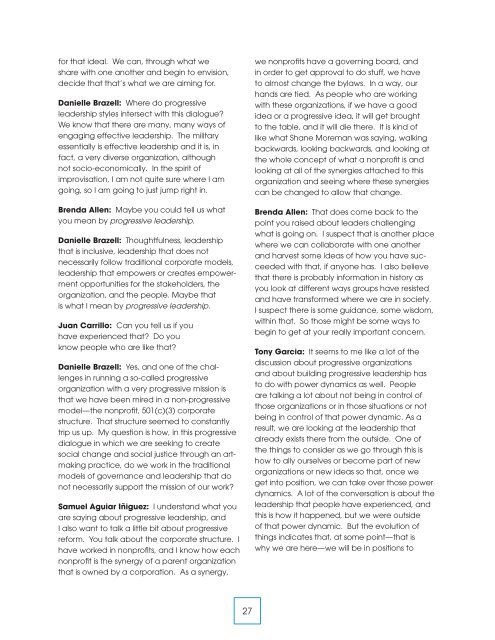The New Face of Arts Leadership in the West - westaf - The Western ...
The New Face of Arts Leadership in the West - westaf - The Western ...
The New Face of Arts Leadership in the West - westaf - The Western ...
You also want an ePaper? Increase the reach of your titles
YUMPU automatically turns print PDFs into web optimized ePapers that Google loves.
for that ideal. We can, through what we<br />
share with one ano<strong>the</strong>r and beg<strong>in</strong> to envision,<br />
decide that that’s what we are aim<strong>in</strong>g for.<br />
Danielle Brazell: Where do progressive<br />
leadership styles <strong>in</strong>tersect with this dialogue?<br />
We know that <strong>the</strong>re are many, many ways <strong>of</strong><br />
engag<strong>in</strong>g effective leadership. <strong>The</strong> military<br />
essentially is effective leadership and it is, <strong>in</strong><br />
fact, a very diverse organization, although<br />
not socio-economically. In <strong>the</strong> spirit <strong>of</strong><br />
improvisation, I am not quite sure where I am<br />
go<strong>in</strong>g, so I am go<strong>in</strong>g to just jump right <strong>in</strong>.<br />
Brenda Allen: Maybe you could tell us what<br />
you mean by progressive leadership.<br />
Danielle Brazell: Thoughtfulness, leadership<br />
that is <strong>in</strong>clusive, leadership that does not<br />
necessarily follow traditional corporate models,<br />
leadership that empowers or creates empowerment<br />
opportunities for <strong>the</strong> stakeholders, <strong>the</strong><br />
organization, and <strong>the</strong> people. Maybe that<br />
is what I mean by progressive leadership.<br />
Juan Carrillo: Can you tell us if you<br />
have experienced that? Do you<br />
know people who are like that?<br />
Danielle Brazell: Yes, and one <strong>of</strong> <strong>the</strong> challenges<br />
<strong>in</strong> runn<strong>in</strong>g a so-called progressive<br />
organization with a very progressive mission is<br />
that we have been mired <strong>in</strong> a non-progressive<br />
model—<strong>the</strong> nonpr<strong>of</strong>it, 501(c)(3) corporate<br />
structure. That structure seemed to constantly<br />
trip us up. My question is how, <strong>in</strong> this progressive<br />
dialogue <strong>in</strong> which we are seek<strong>in</strong>g to create<br />
social change and social justice through an artmak<strong>in</strong>g<br />
practice, do we work <strong>in</strong> <strong>the</strong> traditional<br />
models <strong>of</strong> governance and leadership that do<br />
not necessarily support <strong>the</strong> mission <strong>of</strong> our work?<br />
Samuel Aguiar Iñiguez: I understand what you<br />
are say<strong>in</strong>g about progressive leadership, and<br />
I also want to talk a little bit about progressive<br />
reform. You talk about <strong>the</strong> corporate structure. I<br />
have worked <strong>in</strong> nonpr<strong>of</strong>its, and I know how each<br />
nonpr<strong>of</strong>it is <strong>the</strong> synergy <strong>of</strong> a parent organization<br />
that is owned by a corporation. As a synergy,<br />
we nonpr<strong>of</strong>its have a govern<strong>in</strong>g board, and<br />
<strong>in</strong> order to get approval to do stuff, we have<br />
to almost change <strong>the</strong> bylaws. In a way, our<br />
hands are tied. As people who are work<strong>in</strong>g<br />
with <strong>the</strong>se organizations, if we have a good<br />
idea or a progressive idea, it will get brought<br />
to <strong>the</strong> table, and it will die <strong>the</strong>re. It is k<strong>in</strong>d <strong>of</strong><br />
like what Shane Moreman was say<strong>in</strong>g, walk<strong>in</strong>g<br />
backwards, look<strong>in</strong>g backwards, and look<strong>in</strong>g at<br />
<strong>the</strong> whole concept <strong>of</strong> what a nonpr<strong>of</strong>it is and<br />
look<strong>in</strong>g at all <strong>of</strong> <strong>the</strong> synergies attached to this<br />
organization and see<strong>in</strong>g where <strong>the</strong>se synergies<br />
can be changed to allow that change.<br />
Brenda Allen: That does come back to <strong>the</strong><br />
po<strong>in</strong>t you raised about leaders challeng<strong>in</strong>g<br />
what is go<strong>in</strong>g on. I suspect that is ano<strong>the</strong>r place<br />
where we can collaborate with one ano<strong>the</strong>r<br />
and harvest some ideas <strong>of</strong> how you have succeeded<br />
with that, if anyone has. I also believe<br />
that <strong>the</strong>re is probably <strong>in</strong>formation <strong>in</strong> history as<br />
you look at different ways groups have resisted<br />
and have transformed where we are <strong>in</strong> society.<br />
I suspect <strong>the</strong>re is some guidance, some wisdom,<br />
with<strong>in</strong> that. So those might be some ways to<br />
beg<strong>in</strong> to get at your really important concern.<br />
Tony Garcia: It seems to me like a lot <strong>of</strong> <strong>the</strong><br />
discussion about progressive organizations<br />
and about build<strong>in</strong>g progressive leadership has<br />
to do with power dynamics as well. People<br />
are talk<strong>in</strong>g a lot about not be<strong>in</strong>g <strong>in</strong> control <strong>of</strong><br />
those organizations or <strong>in</strong> those situations or not<br />
be<strong>in</strong>g <strong>in</strong> control <strong>of</strong> that power dynamic. As a<br />
result, we are look<strong>in</strong>g at <strong>the</strong> leadership that<br />
already exists <strong>the</strong>re from <strong>the</strong> outside. One <strong>of</strong><br />
<strong>the</strong> th<strong>in</strong>gs to consider as we go through this is<br />
how to ally ourselves or become part <strong>of</strong> new<br />
organizations or new ideas so that, once we<br />
get <strong>in</strong>to position, we can take over those power<br />
dynamics. A lot <strong>of</strong> <strong>the</strong> conversation is about <strong>the</strong><br />
leadership that people have experienced, and<br />
this is how it happened, but we were outside<br />
<strong>of</strong> that power dynamic. But <strong>the</strong> evolution <strong>of</strong><br />
th<strong>in</strong>gs <strong>in</strong>dicates that, at some po<strong>in</strong>t—that is<br />
why we are here—we will be <strong>in</strong> positions to<br />
27


